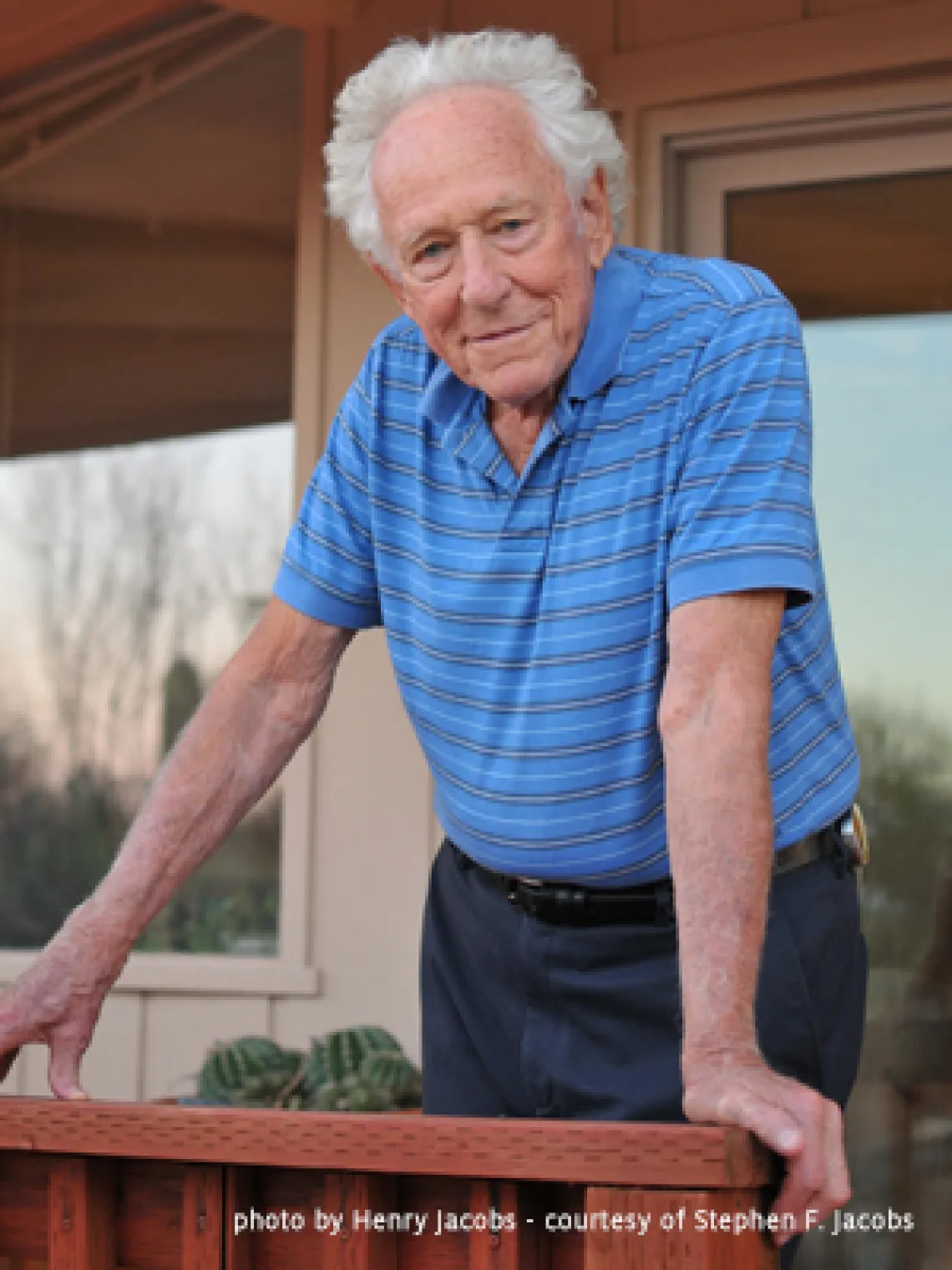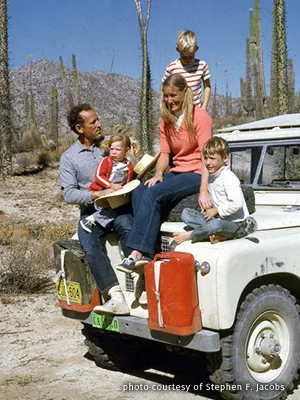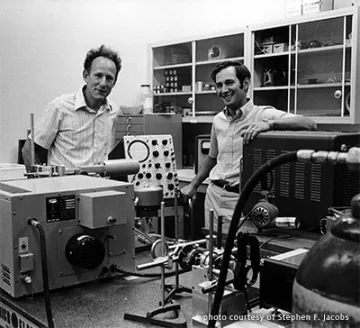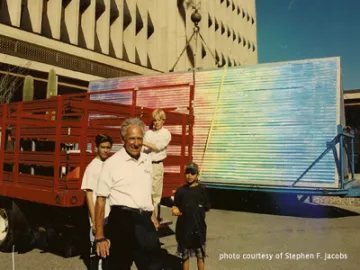Reflections, Special Birthday Edition: Stephen Jacobs

In 1965 Aden Meinel, founder of the Optical Sciences Center at the University of Arizona, was looking for a laser scientist to join himself, Roland Shack and Bob Noble in the desert. So Steve Jacobs and his wife, Kathy, left their life in Greenwich Village, NYC and headed west to Tucson. The rest — as they say — is history. Steve remained a member of the faculty at OSC until 1996 when he retired and became professor emeritus.
On Monday, Oct. 1, Professor Emeritus Stephen F. Jacobs will celebrate his 90th birthday and his 53rd year as a member of the OSC family. The year Steve was born (1928), Calvin Coolidge was President; Amelia Earhart successfully flew her plane east across the Atlantic Ocean; Mickey Mouse appeared for the first time in Steamboat Willie; and Otto Rohwedder invented the world’s first bread-slicing machine — securing a place in history for the commonly used idiom, best thing since sliced bread.
I recently caught up with Steve at his office which, amazingly, he has occupied since the opening of the Meinel Building in 1970, and still tries to visit as often as possible. I thought it would be fun to ask him a few questions about how he sees the world, what he values, and to what he attributes his own longevity. Hence, this birthday interview …
You were born during the Great Depression and right before the Wall Street Crash of 1929. How did these events affect your family?
My father was a Colombia University trained civil engineer, but one of my most vivid memories is of him candling and peddling eggs in Greenwich Village during the Great Depression. He would candle the eggs at night in our apartment, then load them into a black, cardboard suitcase with dividers. The next morning he would walk door-to-door selling the eggs.

What have been the biggest news events during your lifetime?
The bombing of Pearl Harbor in 1941 and the end of WWII in 1945. More recently, the Sept. 11, 2001, attacks on the World Trade Center. Kathy and I were in Florence, Italy, visiting our dear friend Giuseppe Molesini and his family. We watched the horrifying destruction of the towers on television in their apartment.
What would you consider the most important invention of your lifetime?
There are many but I would probably have to say it was the building block for the processor — the transistor. I was an undergraduate at Antioch College in Yellow Springs, Ohio, when Bell Labs invented the transistor in 1947, and had just received my Ph.D. in Physics from Johns Hopkins University when the first transistor radio became available to buy.
How would you define a good life or a successful life?
Salud, amor, dinero y el tiempo para disfrutarlos. Health, love and money and the time to enjoy them.
What are the major values or principles that you have lived by?
Be kind, gracious and thoughtful. Also be creative and never cease to try to find solutions to problems.
Who has had the greatest positive influence on your life?
My maternal grandfather, Leo Frank. After my father’s death in 1940 and my grandmother’s death two years later, my mother moved the family to Manhattan to live with my grandfather. He ran a business, Frank & Son, that manufactured and sold furniture. But he was really a teacher — always teaching his family. As an avid tennis player himself, he greatly influenced my life-long love for tennis.
What would you say you know now about living a happy and successful life that you didn’t know when you were 20 years old?
Nothing, really. I just kept — and still keep — seeking to use my few talents.
What do you consider the secret to your longevity?
Good genes that my older sister Judy (93 years old) and I inherited from my mother’s side of the family. My grandfather lived until he was 88 and my mother died at the age of 97. She was still driving — although not unaccompanied — until the end.
What is your typical day?
At 90 years old, it is desert gardening, duplicate bridge and exercise.

What do you regularly do for exercise?
Swimming, tennis and a personal fitness trainer. Until recently, when I fell on the court, I was playing tennis five days a week. These days I play only two days a week. Luckily for me, I have a couple of very patient tennis partners who aim to hit the ball to where I am standing.
I have had the pleasure of hearing you play your steel drum. What other musical instruments do you play?
Violin, guitar, dulcimer, accordion and banjo. I once wooed a pretty, young girl named Kathy picking tunes on a five-string banjo at a rooftop party in New York City. That girl became my wife.
You started your professional career as an optical engineer at Perkin-Elmer Corporation in Norwalk, Connecticut, then eventually ended up in academia at the University of Arizona. What were the career turning points that caused you to change tracks?
After four years at Perkin Elmer, I realized I had no great talent as an optical engineer. So in 1960 I began looking for a new job. I got lucky at the Physical Society meeting in New York City when someone, who knew I had been trained in spectroscopy at Johns Hopkins, introduced me to Gordon Gould of the Technical Research Group (TRG). Gordon was looking for a spectroscopist to help demonstrate his 1957 teachings — How to Build an Optical Amplifier. He hired me and Paul Rabinowitz. We succeeded in measuring light amplification in 1961 and in building a laser oscillator in 1962.
Around this time, TRG was purchased by Control Data Corporation and I — once again — began to look for new employment. Roland Shack, whom I had worked with at Perkin Elmer, invited me to join him, Bob Noble and Aden Meinel in Arizona. I became OSC’s first laser man in the desert.
For you, what have been the highlights of your long career at OSC?
In some ways, I consider my career as an optical scientist undistinguished but I was good at teaching — and was well-organized, creative and flexible.
When I first arrived at OSC in 1965, we had offices in Steward Observatory. One day I was asked by University President John P. Schaefer to accompany him and Vice President Richard Kassander on a trip to Reno to recruit O. Richard Norton to build a planetarium at Arizona. I later asked Schaefer “Why me?” and he responded “we could see you are an outreach person.” We got Norton and funding from Grace Flandrau.
Later, with ample space in the new Optical Sciences Building, I went about assembling 20 cases of interactive optics exhibits. In 1970 lasers were new and spectacular. I went around to various clubs with my dog-and-pony show teaching a little and begging for volunteers to help build the exhibit. Completed in 1973, it became a showcase at the University — located on the fourth floor around the optical test tower. Several years later it was dismantled to make room for visiting scientists. Many exhibits were transferred to Flandrau Planetarium.

In order to cover part of my salary, I established a dimensional stability laboratory to measure time and temperature stability of materials for optical engineering. My lab was effectively a National Bureau of Standards — serving over 50 customers between 1980 and 2008. Successful collaborative projects included determining quartz homogeneity for the Gravity Probe B relativity experiment; working with Roger Angel, Steward Observatory Mirror Lab, to identify the most homogeneous glass for spin casting; and assisting NASA’s Jet Propulsion Laboratory (JPL) in the development of the ultrastable Invar 36 for the Cassini spacecraft.
Examples of your creativity are on display in several places around the Meinel Building — Folding Along the Curve Sculpture on the 8th floor, Giant Polished Glass Sphere in the lobby, and a photo of your Diffractive Fish in the Sea of Cortez on the 4th floor. You also have a Sun Clock outside the Kitt Peak Museum and a Wavy Grating atop Tucson City Hall. What has been your favorite project?
I consider my best invention to be a huge outreach idea in 1996 — to show the people of Tucson the beautiful brilliant colors of the sun’s spectrum. After a lot of publicity and commentary, I received permission from Tucson City Council to place a 50’ diffraction grating atop City Hall. I designed a way to send light in all directions by attaching diffractive material to a wavy surface made of corrugated steel. The colors reflected from the top of City Hall are still widely visible all over downtown Tucson.
Authors Note: A complete biography of Steve — including more info about his art/outreach projects — can be found in Reflections: Stephen Jacobs.
